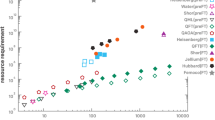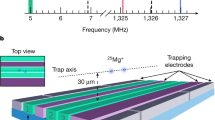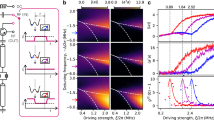Abstract
Entangled states are a key resource in fundamental quantum physics, quantum cryptography and quantum computation1. Introduction of controlled unitary processes—quantum gates—to a quantum system has so far been the most widely used method to create entanglement deterministically2. These processes require high-fidelity state preparation and minimization of the decoherence that inevitably arises from coupling between the system and the environment, and imperfect control of the system parameters. Here we combine unitary processes with engineered dissipation to deterministically produce and stabilize an approximate Bell state of two trapped-ion quantum bits (qubits), independent of their initial states. Compared with previous studies that involved dissipative entanglement of atomic ensembles3 or the application of sequences of multiple time-dependent gates to trapped ions4, we implement our combined process using trapped-ion qubits in a continuous time-independent fashion (analogous to optical pumping of atomic states). By continuously driving the system towards the steady state, entanglement is stabilized even in the presence of experimental noise and decoherence. Our demonstration of an entangled steady state of two qubits represents a step towards dissipative state engineering, dissipative quantum computation and dissipative phase transitions5,6,7. Following this approach, engineered coupling to the environment may be applied to a broad range of experimental systems to achieve desired quantum dynamics or steady states. Indeed, concurrently with this work, an entangled steady state of two superconducting qubits was demonstrated using dissipation8.
This is a preview of subscription content, access via your institution
Access options
Subscribe to this journal
Receive 51 print issues and online access
$199.00 per year
only $3.90 per issue
Buy this article
- Purchase on Springer Link
- Instant access to full article PDF
Prices may be subject to local taxes which are calculated during checkout



Similar content being viewed by others
References
Nielsen, M. A. & Chuang, I. L. Quantum Computation and Quantum Information (Cambridge Univ. Press, 2000)
Ladd, T. D. et al. Quantum computers. Nature 464, 45–53 (2010)
Krauter, H. et al. Entanglement generated by dissipation and steady state entanglement of two macroscopic objects. Phys. Rev. Lett. 107, 080503 (2011)
Barreiro, J. T. et al. An open-system quantum simulator with trapped ions. Nature 470, 486–491 (2011)
Kraus, B. et al. Preparation of entangled states by quantum Markov processes. Phys. Rev. A 78, 042307 (2008)
Diehl, S. et al. Quantum states and phases in driven open quantum systems with cold atoms. Nature Phys. 4, 878–883 (2008)
Verstraete, F., Wolf, M. M. & Cirac, J. I. Quantum computation and quantum-state engineering driven by dissipation. Nature Phys. 5, 633–636 (2009)
Shankar, S. et al. Autonomously stabilized entanglement between two superconducting quantum bits. Nature http://dx.doi.org/10.1038/nature12802 (this issue)
Lanyon, B. P. et al. Universal digital quantum simulation with trapped ions. Science 334, 57–61 (2011)
Hanneke, D. et al. Realization of a programmable two-qubit quantum processor. Nature Phys. 6, 13–16 (2010)
Sayrin, C. et al. Real-time quantum feedback prepares and stabilizes photon number states. Nature 477, 73–77 (2011)
Vijay, R. et al. Stabilizing Rabi oscillations in a superconducting qubit using quantum feedback. Nature 490, 77–80 (2012)
Ristè, D., Bultink, C. C., Lehnert, K. W. & DiCarlo, L. Feedback control of a solid-state qubit using high-fidelity projective measurement. Phys. Rev. Lett. 109, 240502 (2012)
Brakhane, S. et al. Bayesian feedback control of a two-atom spin-state in an atom-cavity system. Phys. Rev. Lett. 109, 173601 (2012)
Schindler, P. et al. Quantum simulation of dynamical maps with trapped ions. Nature Phys. 9, 361–367 (2013)
Campagne-Ibarcq, P. et al. Persistent control of a superconducting qubit by stroboscopic measurement feedback. Phys. Rev. X 3, 021008 (2013)
Ristè, D. et al. Deterministic entanglement of superconducting qubits by parity measurement and feedback. Nature 502, 350–354 (2013)
Poyatos, J. F., Cirac, J. I. & Zoller, P. Quantum reservoir engineering with laser cooled trapped ions. Phys. Rev. Lett. 77, 4728–4731 (1996)
Plenio, M. B., Huelga, S., Beige, A. & Knight, P. L. Cavity-loss-induced generation of entangled atoms. Phys. Rev. A 59, 2468–2475 (1999)
Clark, S., Peng, A., Gu, M. & Parkins, S. Unconditional preparation of entanglement between atoms in cascaded optical cavities. Phys. Rev. Lett. 91, 177901 (2003)
Parkins, A. S., Solano, E. & Cirac, J. I. Unconditional two-mode squeezing of separated atomic ensembles. Phys. Rev. Lett. 96, 053602 (2006)
Kastoryano, M. J., Reiter, F. & Sørensen, A. S. Dissipative preparation of entanglement in optical cavities. Phys. Rev. Lett. 106, 090502 (2011)
Cho, J., Bose, S. & Kim, M. S. Optical pumping into many-body entanglement. Phys. Rev. Lett. 106, 020504 (2011)
Bermudez, A., Schaetz, T. & Plenio, M. B. Dissipation-assisted quantum information processing with trapped ions. Phys. Rev. Lett. 110, 110502 (2013)
Leghtas, Z. et al. Stabilizing a Bell state of two superconducting qubits by dissipation engineering. Phys. Rev. A 88, 023849 (2013)
Reiter, F., Tornberg, L., Johansson, G. & Sørensen, A. S. Steady state entanglement of two superconducting qubits by engineered dissipation. Phys. Rev. A 88, 032317 (2013)
Cormick, C., Bermudez, A., Huelga, S. F. & Plenio, M. B. Dissipative ground-state preparation of a spin chain by a structured environment. New J. Phys. 15, 073027 (2013)
Ticozzi, F. & Viola, L. Steady-state entanglement by engineered quasi-local Markovian dissipation: Hamiltonian-assisted and conditional stabilization. Quantum Inform. Comput.. (in the press); preprint at http://arXiv.org/abs/1304.4270 (2013)
Barrett, M. D. et al. Sympathetic cooling of 9Be+ and 24Mg+ for quantum logic. Phys. Rev. A 68, 042302 (2003)
Reiter, F. & Sørensen, A. S. Effective operator formalism for open quantum systems. Phys. Rev. A 85, 032111 (2012)
Monroe, C. et al. Resolved-sideband Raman cooling of a bound atom to the 3D zero-point energy. Phys. Rev. Lett. 75, 4011–4014 (1995)
Jost, J. D. et al. Entangled mechanical oscillators. Nature 459, 683–685 (2009)
Ozeri, R. et al. Errors in trapped-ion quantum gates due to spontaneous photon scattering. Phys. Rev. A 75, 042329 (2007)
Uys, H. et al. Decoherence due to elastic Rayleigh scattering. Phys. Rev. Lett. 105, 200401 (2010)
Tan, S. M. A computation toolbox for quantum and atomic optics. J. Opt. B 1, 424–432 (1999)
Acknowledgements
This research was funded in part by the Office of the Director of National Intelligence (ODNI), Intelligence Advanced Research Projects Activity (IARPA). All statements of fact, opinion or conclusions contained herein are those of the authors and should not be construed as representing the official views or policies of IARPA or the ODNI. This work was also supported by ONR, by the NIST Quantum Information Program, and by the European Union’s Seventh Framework Program through SIQS (grant no. 600645) and through the ERC grant QIOS (grant no. 306576). We thank D. Allcock and B. Sawyer for comments on the manuscript and E. Knill for conversations. F.R. acknowledges conversations with B. Lanyon, R. Blatt and J. Home and support from the Studienstiftung des deutschen Volkes. This Letter is a contribution of NIST and is not subject to US copyright.
Author information
Authors and Affiliations
Contributions
Y.L. and J.P.G. performed the experiments, analysed the data and developed the numerical model. F.R. proposed the entanglement scheme and developed the analytic rate model described in Supplementary Information under the guidance of A.S.S. T.R.T. contributed to the numerical model and the experimental apparatus. R.B. contributed to the experimental apparatus. D.L. and D.J.W. directed the experiments. All authors provided important suggestions for the experiments, discussed the results and contributed to the manuscript.
Corresponding author
Ethics declarations
Competing interests
The authors declare no competing financial interests.
Supplementary information
Supplementary Information
This file contains Supplementary Text, Supplementary Figures 1-2 and additional references. (PDF 212 kb)
Rights and permissions
About this article
Cite this article
Lin, Y., Gaebler, J., Reiter, F. et al. Dissipative production of a maximally entangled steady state of two quantum bits. Nature 504, 415–418 (2013). https://doi.org/10.1038/nature12801
Received:
Accepted:
Published:
Issue Date:
DOI: https://doi.org/10.1038/nature12801
This article is cited by
-
Stationary states of a dissipative two-qubit quantum channel and their applications for quantum machine learning
Quantum Machine Intelligence (2023)
-
Stochastic Entropy Production: Fluctuation Relation and Irreversibility Mitigation in Non-unital Quantum Dynamics
Journal of Statistical Physics (2023)
-
Trade off-free entanglement stabilization in a superconducting qutrit-qubit system
Nature Communications (2022)
-
Engineered dissipation for quantum information science
Nature Reviews Physics (2022)
-
Quantum algorithms for simulation of quantum chemistry problems by quantum computers: an appraisal
Foundations of Chemistry (2022)
Comments
By submitting a comment you agree to abide by our Terms and Community Guidelines. If you find something abusive or that does not comply with our terms or guidelines please flag it as inappropriate.



